The End of the World, Part I: H. G. Wells
From the desk of Thomas F. Bertonneau on Tue, 2011-09-13 16:00
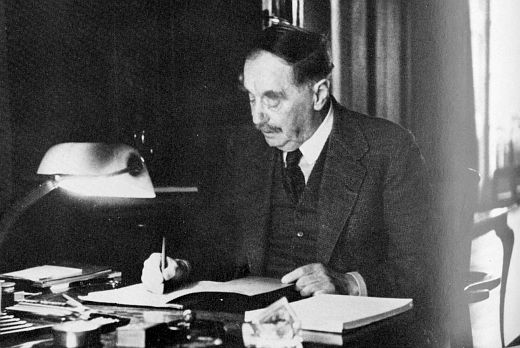
The End of the World is an apocalyptic myth that first becomes prominent in religious speculation in the period of Late Antiquity. St. John’s Apocalypse, included as the last book of the New Testament, is the best-known item in the genre, with its elaborate visions of Armageddon and the Last Judgment. Persistently, however, since the French Revolution, the myth of the End of the World has secularized itself, expressing its eschatological anxiety in terms of entirely this-worldly events. In the Twentieth Century, the End of the World became a staple of “scientific romance” or science fiction, where it often concerned the perfection of destructive instrumentality. In England beginning in the 1870s, the foreign invasion story became popular. In George Tomkyns Chesney’s many times reprinted Battle of Dorking (1871), Kaiser Wilhelm I, not content with the defeat of France at Sedan, pushes on through Belgium and the Netherlands, crosses the Channel, and reduces Britain to vassalage. Sometimes the invasion involved the so-called Yellow Peril, an onslaught, in some non-specific near future, by militarized hordes of Chinese or Japanese, who overwhelm Europe.
The End of the World typically presents itself in a literalist manner, with the physical obliteration of the globe and humanity. The antecedents in this case go as far back as the first half of the Nineteenth Century, especially to the American writer Edgar Allan Poe (1809 – 1849). Best known as the inventor of the detective story, Poe also established the broad outlines the science fiction story. Poe’s “Conversation of Eiros and Charmion” (1839), the earliest tale of a cosmic collision that destroys humanity, climaxes in a planetary conflagration when, the chemistry of the comet’s tail having removed all nitrogen from earth’s airy mixture, the remaining oxygen-rich atmosphere induces all organic matter to burst into flame. Astronomer and science journalist Camille Flammarion (1842 – 1925) expanded on Poe’s innovation in his novel Le fin du monde (1893) where once again a cosmic interloper brings death to the earth, destroying it in a direct collision. Abel Gance loosely adapted Flammarion’s novel to the silver screen in 1931. Both Poe’s short story and Flammarion’s novel include descriptions of future, decadent civilizations, in thrall to which much of human nature has already gone extinct even before the physical cataclysm occurs.
The greatest interest of the End of the World in fiction comes, in fact, not from the cosmic, but rather from the sociological, political, and civilizational variants of the trope. A world-obliterating impact leaves no survivors and ceases to be pathetic in the instant when it occurs; but social, political, and civilizational catastrophes reserve a few survivors, who attest to their experience and add, perhaps, to humanity’s small store of wisdom. None was better at this type of End-of-the-World story than Herbert George Wells (1866 – 1946). He made an early success of such a tale in The Time Machine (1895) and his very last book, The Mind at the End of its Tether (1946), is the oddest and most disturbing End-of-the-World story of all, except that Wells insists that it is the not a story but the apocalyptic truth.
I. Wells wrote two planetary collision stories, borrowing the idea from Poe’s “Conversation.” These are “The Star” (1897) and In the Days of the Comet (1906). In “The Star” – where Wells achieves an impartial, objectively analytical tone that he would refine in his novel-length catastrophe stories – the real disaster is human complacency, as it would be again in many of the same author’s “scientific romances.” Even in the civilized nations, Wells asserts, people rarely develop their awareness beyond the demands of routine and immediacy; while petty worries eat up its quotient of starveling intelligence, the typical modern mind altogether lacks a cosmic sense. When the astronomer Ogilvy calls attention to a “retardation” in the orbital velocity of the eighth planet, “such a piece of news was scarcely calculated to interest a world the greater portion of whose inhabitants were unaware of the existence of Neptune, nor… did the subsequent discovery of a faint, remote speck of light in the region of the perturbed planet cause any very great excitement.” Even after the interloper, in colliding with Neptune, becomes visible in daylight, effulgent and growing, the putatively educated regard the phenomenon blandly as a stellar novelty without implication for their lives. The most backward and superstitious people, by contrast, invest the “fiery signs” with due portentousness. In Europe and America only the perspicacious few grasp the likelihood that, “Man has lived in vain.” Otherwise, as Wells writes, “shops... opened and closed at the proper hours” and “use and wont still ruled the world.”
The celestial body’s inevitable near-encounter with Earth solicits the full range of cataclysm in massive tsunamis, conflagration of the atmosphere, deluge, and seismic tremor, all of which leave a small stunned nucleus of survivors huddling in the wreckage. Wells hints at “a new brotherhood,” emerging from the shock and ruin of an altered geography, which organizes “the saving of laws and books and machines.” This too would become a standard Wellsian trope. “The Star” ends with a sudden, unexpected shift of perspective. Martian astronomers assess the event as “astonishing” in consideration of “what little damage the earth… has sustained.” “The Star” tells objectively of a catastrophe cosmic on the one hand and intellectual on the other. The intellectual debacle interests Wells more than the cosmic one. The Wellsian brand of Darwinism focuses much less on physiological than it does on psychological, ethical, and technical adaptation, as narrowly biological as Wells could nevertheless sometimes be. Stultified minds fail to grasp either the scale or the peril of universal forces.
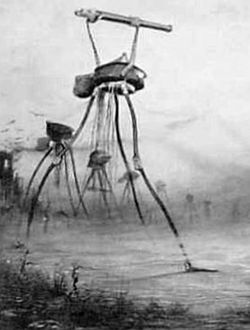
The magnificent opening paragraph of The War of the Worlds (1897) enjoys notoriety – from its partial rehearsal in the several, filmed versions of the scenario – to the extent that commenting on it strikes the writer as presumptive. Nevertheless, the same opening paragraph develops motifs from “The Star,” particularly “use and wont,” in such a way as to invite a renewal of consideration. Logicians urge that argument from analogy offends against forensic procedure, but Wells would have it that the main ingredient of complacency, which he again condemns, is the failure to consider analogies. The whole of Wells’ paragraph operates analogically. Wells invokes “intelligences greater than man’s,” mentalities “vast, cool and unsympathetic,” by which men have been “scrutinized and studied almost as narrowly as a man with a microscope might scrutinize the transient creatures that swarm and multiply in a drop of water.” That men “with infinite complacency” felt “assurance” in what Wells calls “their empire over matter,” belongs, as the narrator says, to the class of “mental habits… of departed days.”
From the history of the European empires The War’s discourse draws in various items of unavoidable pertinence. The narrator, writing from a vantage point six years after the Martian attempt, details the onslaught’s effects in Britain, but far from wringing his hands in resentful anger he seems actually to mitigate the enemy’s blameworthiness: “Before we judge [the Martians] too harshly we must remember what ruthless and utter destruction our own species has wrought, not only upon animals, such as the vanished bison and the dodo, but upon its own inferior races.” The Tasmanians come under discussion, who, “in spite of their human likeness, were swept out of existence in a war of extermination waged by European immigrants.” Mars being a world “far gone in its cooling” while the earth “is still teaming with life,” and life being everywhere “an incessant struggle for existence,” the Martians acted logically to avoid “the destruction that generation after generation creeps upon them.” The failure of the Martian attempt to wrest earth and its resources prompts the invaders to turn their attention elsewhere. “Lessing has advanced excellent reasons,” writes the narrator in the Epilogue, “for supposing that the Martians have actually succeeded in effecting a landing on Venus.”
The main interest for most readers in The War of the Worlds consists in Wells’ vivid descriptions of mechanized warfare between a British military that fights with the armaments of the Boer and Spanish-American Wars and an attacking force whose weaponry marks a quantum leap in applied science. The “heat ray” anticipates the beam weapons that modern armories still have not perfected, while the “black smoke” uncannily prefigures the poison gas that belligerents would unleash during the trench-warfare of 1914-1918. The Martians dominate the battlefield. Occasionally, a crack British gun crew or an astute dreadnaught commander scores a tactical victory. The fragility of the British social fabric, however, almost as much as Martian technical superiority, supplies the invader with his most effective instrument of war. Once the Martians emerge from their initial “pit” at Horsell Common near Woking, Surrey, panic spreads infectiously. “The most extraordinary thing to my mind,” writes the narrator, “was the dovetailing of the commonplace habits of our social order with the first beginnings of the series of events that was to topple that order headlong.”

Information becomes a casualty. The sudden paucity of news, disrupting use and wont, in turn exacerbates the rising hysteria, which in its own turn propels the disintegration of social order. In London, with trains gone missing and the railway timetables now useless, a great exodus on foot begins, which quickly degenerates into mob-behavior and lawlessness. The narrator’s brother, a medical student in London, witnesses the rapid descent into chaos. He records “a roaring wave of fear that swept through the greatest city in the world… the stream of flight rising swiftly to a torrent, lashing in a foaming tumult around the railway stations, banked up into a horrible struggle about the shipping in the Thames, and hurrying by every available channel northward and eastward.” In the company of two fleeing women, the brother resorts to a revolver to fight off criminal opportunists. Near the suburb of Edgeware, “the main road was a boiling stream of people”; a bit farther, they encounter “a whole population in movement,” whose constituents wear “fear and pain on their faces.” Martian vulnerability to terrestrial infections stops the attack, a kind of secular Providence.
In the Epilogue, the narrator remarks, “Whether we expect another invasion or not, our views of the human future must be greatly modified by these events,” which “have robbed us of that serene confidence in the future which is the most fruitful source of decadence.” Wells is once again playing with analogies. Self-absorption and unfounded certainty prevented humanity from foreseeing the Martian attack; self-absorption and unfounded certainty prevented the Martians from foreseeing their sanitary incompatibility with the earth’s bacterial environment. Humanity found lucky redemption from the mentality of use and wont – of complacency – that made it prey to the Martians in the Martian complacency that prevented the invaders from imagining untoward conditions on a new world.
II. A good academic parlor game would be to pose the question, what English-language novel of the first quarter of the Twentieth Century innovatively takes its plot from Homer’s Odyssey while updating the action in a modern setting? Or one might ask, also of the professoriate during cocktail hour, what thinker first articulated the principle of escalation, usually attributed to Herman Kahn, and who, before 1910, described an aerial terror-attack on New York City? The bafflement of the literature and political science faculties would likely be complete because today almost no one reads one of the most popular British writers of the first half of the just-completed century. These questions implicate Wells’ prophetic vision of global strategic conflict, The War in the Air (1906). Whereas in The War of the Worlds, the hostile agency, actually inhuman, arrives on earth from another planet, in The War in the Air, dear old humanity rises to the role of its own devil. In particular, haphazard adoptions of new technology put unforeseen strains on social, political, and economic arrangements that reflect the folkways of an earlier age. Old habits, stubbornly maintained, prove inadequate to developing circumstances until a type of cultural schizophrenia occurs. “Things fall apart, the center cannot hold,” as a noteworthy Irish poet with a prophetic turn of mind would later write. Wells was quite as vatic and clairvoyant as any poet.

The first sentence of The War in the Air is, “This here progress… it keeps on.” Tom Smallways, the protagonist’s elder brother, mutters the thought, a bit of non-committal, vaguely skeptical commentary from a bewildered soul representing a vestige of feudal mentality that has not, and perhaps cannot, keep up with changes in the mode of life. Bert Smallways, Wells’ working-class substitute for a Homeric hero, grasps his brother’s limitation dimly. The younger Smallways suffers, however, from similar intellectual narrowness through lack of education and by subservience to a jejune popular culture. For the plot-driving device of The War, Wells arranges that his hero-by-accident, a bicycle repairman who graduates to motorcycles, should be rapt skyward from Brighton Beach when he impulsively but stupidly attempts to rescue a lady from her imperilment in the basket of an errant balloon. Chance precipitates Smallways into the center of global events – the titular “War” – that he enjoys the privilege to observe. The Germans, among whom Smallways falls, have girded themselves for war, building in secret an armada of airships. They mistake Smallways for a certain Butteridge, who has perfected the design of an airplane.

Smallways, “a very image of the democratic mind confronted with problems too complex for its apprehension,” has hitherto failed to remark the international tensions heralded in newspaper placards: “WAR A QUESTION OF HOURS. NEW YORK CALM. EXCITEMENT IN BERLIN.” The logic of an armaments race fascinated Wells, who saw in it the paradigm of unforeseen consequences accruing from the shock and stress of technical innovation on habituated but fragile systems. On the one hand “the development of science had altered the scale of human affairs”; on the other the nations, “wanting in generous imagination,” chafed at “a newer, wider synthesis.” The very “coalescence” of the world in commerce produces the reaction whereby nationalism, which has its reasons, becomes jingoism. In The War of the Worlds, the Martians are actual aliens; in The War in the Air men become dehumanized, hence alien to themselves. Wells invokes “Nietzsche’s Overman,” as vulgarly received, to suggest the devolution. Attacking from their aerial redoubts, combatants join battle with diminished sympathy for the foe, now a maneuvering counterforce and now a civilian population, defenseless.
Lieutenant Kurt, who befriends Smallways, struggles with his own wounded conscience when he comments, during the aerial destruction of the American Atlantic Fleet at sea, that, “It makes one a little swimmy in the head at first,” but, “as for the killing, we’ve got to be blooded.” These new-type soldiers must suppress their humanity – “be blooded.” The Blitzkrieg with Zeppelins demands it. The “Overman” demands it. Smallways at first while surveying the destruction feels “detached, disembodied” but in “sheer blank horror” at the sight of burned and drowning men he recovers his pity for the victims: “‘Oh, Gord,’ he cried, ‘Oh, Gord!’” Swiftly enough Smallways can attest to worse, the terror bombing of New York City, and the clash of the Japanese and German air armadas over Niagara Falls. A German radio operator reports, “All de vorld is at vor.” He adds, “They haf’ burn’ Berlin; they haf’ burn London; they haf’ burn Hamburg and Paris.” Bert wonders whether they have burned his native village of Bun Hill and whether his betrothed, Edna, is still among the living. Edna stands Penelope to Bert’s Odysseus, in Wells’ Homeric parallelism.
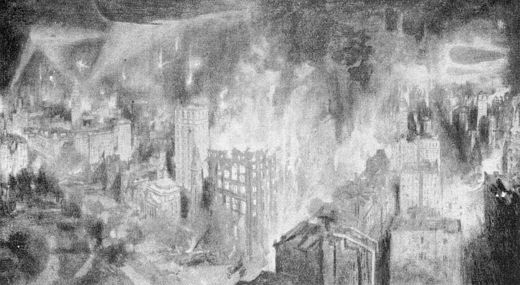
As soon as Imperial Germany makes its bellicosity known, the logic of the preemptive strike comes into effect. Everywhere, as Wells puts it, roused by ambush from the sky and “in a state of passionate emotion and heroic unconquerableness,” one nation after another seeks violently to disarm its enemies until “the war became perforce a universal guerrilla war… inextricably involving civilians and homes and all the apparatus of social life.” The deliquescence of civilization that Wells represents in The War in the Air resembles by authorial design the breakdown of the heroic world’s social order that Homer depicts in The Odyssey. In The War, Wells makes use of a pseudo-documentary type of narrative that if he did not invent he perfected. The novel’s narrator writes from a temporal perspective long after the war, perhaps centuries after it. He collates the “surviving fragments of literature” from what amounts to a Dark Age, attempting imaginative reconstructions of events. He draws essayistic conclusions. “And now,” he writes, “the whole fabric of civilization was bending and giving, and dropping to pieces and melting in the furnace of war.” A great “hallucination of security” rears up in evidence.
In words that have particular relevance to the incipient Twenty-First Century, Wells’ narrator calls attention to the fragility of the global economic system. With the annihilation of the major navies and “the burning and wrecking of billions of pounds’ worth of property in the four cardinal cities of the world,” all faith in paper currency and credit vanishes in a panic urge “to secure and hoard gold.” Commerce has ceased in the same moment when “the economic world staggered and fell dead.” In the “universal social collapse” that follows, the Muslim world whips itself into “Jehad,” China disintegrates into battling warlord fiefdoms, and the Western nations see a recrudescence of ancestral barbarity: “Famine was in every working-class quarter in the world” and “there was not a city anywhere in which the ordinary law and social procedure had not been replaced by some form of emergency control.” In the “Phase of Emergency” the modern world merely breathed its last gasp. Civilization, as the narrator writes, “passed at a stride from a unity and simplicity broader than that of the Roman Empire at its best to a social fragmentation as complete as the robber-baron period of the Middle Ages.”
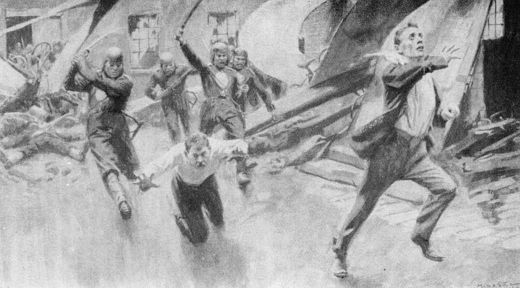
By Cockney stubbornness Smallways, after many a month, finds his way back to Bun Hill. Edna, as he discovers, has been given the choice of Penelope, to wed herself will-she or nill-she to a gangster-suitor who has muscled his way into boss-status in the disintegrative free-for-all. Like Odysseus, Smallways restores a semblance of order through brutally dispatching the adversary. Bun Hill comes under the authority of Bert’s “Vigilance Committee.” Wells knew his history. From the Trojan War, in whose wake Odysseus made his adventuring way, to the revival of Greek civilization in the Eighth Century BC there stretched an illiterate hovel-misery of some four hundred years. Readers may assume that the “War in the Air” likewise issued in a wretchedness of centuries.
III. The ideas of “use and wont” on the one hand and of a “hallucination of security” on the other fit together neatly. The latter, in Wells’ judgment, always haunts the former. Complacency cannot imagine its own precariousness, but what one takes for a stable way of life might collapse in disorder overnight. Nor is this speculation only. Wells’ speculative futures always put their taproot in the historical record, which offers a plethora of civilizational calamities. In A Short History of the World (1923), Wells writes of the Greeks, before their Eighth-Century BC renaissance, that, “they seem to have lived… in open villages of huts around the halls of their chiefs outside the ruins of the Aegean cities they had destroyed.” Of Western Europe in the Fifth Century AD, the time of the Gothic and Hunnic incursions, he writes that, “all over… barbarian chiefs were now reigning as kings” or more accurately as “brigand rulers.” Either way, “life was insecure and property was held by the strong arm.” Letters and learning were lost arts. The End of the World can happen, Wells constantly proposed, because it has happened. The repetition of calamity in Wells’ novels reflects the repetition of calamity in history.
The War in the Air would acquire a sequel. Little read today, The World Set Free (1913) nevertheless bids fare for the title of Wells’ most startlingly prophetic sally, while at the same time it revisits the tropes and motifs of its precursor. Once again Wells tells the story how a technical innovation provokes radical instability in the society, then conflict, and then a reconstruction of order. The War in the Air devotes itself entirely to provocation and destruction. The World Set Free divides itself into halves, the second half detailing the utopian reconstruction of the late, great ordo seclorum. The second half is philosophically more stimulating than the first, but the first is a good deal more exciting to read. Once again as in The War in the Air the exegetical gimmick is that a narrator distantly futural to the story he tells is collating historical documents into a continuous readable pattern. A physicist, Holsten, starting from his study of phosphorescence, comes to investigate radioactive disintegration, over which, in 1933, he gains tentative control in laboratory conditions.
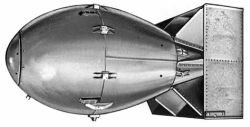
Burns on chest and hands from the flash of his success, his mind racing, Holsten walks London of a spring morning. In the aggregate of architectural styles, cheap architecture, and incessant tearing down and building up, Holsten perceives “the illogical quality of humanity.” He imparts his discovery to an old friend, but the friend grasps none of it. He overhears a couple planning their marriage, assuming “little successes amidst conditions securely fixed.” Atomic disintegration, that “petard under the seat of the current civilization,” will un-fix those “fixed conditions,” as Holsten knows. The Wellsian chain-reaction, in leaving gold as its byproduct, leads “quite naturally to a rise in prices throughout the world.” Making other sources of power and locomotion obsolete, the atomic engine writes finis to whole industries. People by the hundreds of thousands find themselves unemployed. Only lawyers prosper. The narrator observes “the blindness, the narrowness, the insensate, unimaginative individualism of the pre-atomic time.” New forces “so little governed” must burst forth in war, or that is anyway how Wells sees things.
The atomic war breaks out in 1958. The spasm of it lasts a short time into 1959. For his account, the narrator draws on a surviving document, Frederick Barnet’s Wander Jahr, a personal memoir published after the war. Barnet looses his fortune in the shifting economy, experiences unemployment, joins the army as a junior officer and goes with the Allied expedition to the Lowlands when the conflict breaks out. Barnet saves his men by quick thinking when the Central Powers blow up the dykes with atomic bombs and the North Sea reclaims much of Holland. The atomic war, like the “War in the Air,” follows the logic of “tit for tat,” in a phrase used by “a rather brutish young aviator… black hair cropped ‘en brosse’” when he takes off for Berlin to avenge the obliteration of Paris. “By the spring of 1959 from nearly two hundred centres, and every week added to their number, roared the unquenchable crimson conflagrations of the atomic bombs.” Immaterial things, like “the flimsy fabric of the world’s credit,” have crashed down, “and over great areas government was at an end.”

The editorial framework of The World Set Free will tempt some modern readers to dismiss the novel as ideological and propagandistic. While no more orthodox in his socialism than he was in anything else, Wells nevertheless ardently advocated for a centrally administered “World Republic” organizing itself along scientific lines. The novel has Barnet noting in his memoir that the impressive “March of the Unemployed” in London on the eve of conflict signified a subconscious craving for the “intelligence” that the existing improvised civilization so conspicuously lacked. Already in indicting “individualism” Wells will have offended the libertarian sensibility, but perhaps in recalling the synonyms of “individualism” in its privative form – self-absorption, egocentrism, and careerism – the perspicacious reader will find grounds for mitigating his suspicion. That reader will readily agree with Holsten, for example, that in a cumulus of profligate lawmaking and business regulation, order will become its opposite and enterprise will be strangled. “The law is the most dangerous thing in the country,” Holsten opines in his diary after a civil trial concerning a dispute over patents.
The perspicacious reader might agree with Wells that in many ways the existing civilization, whether it is 1913 or 1958 or 2011, puts too much faith in “established words” while being “invincibly blind to the obvious in things,” or that, in areas of the great cities, whether then or now, “social organization was still in the barbaric stage.” It is a matter of no little astonishment that a writer of 1913 should depict a time, not so distant from his own, when “a man could carry about in a handbag an amount of latent energy sufficient to wreck half a city.” How much of modern Western life is organized nowadays to prevent just that? And does not the security regime overtaking the Western nations entail in itself the abolition, at least partially, of the civilized background to life that it declares itself to protect? Within months of the publication of The World Set Free, a savage war embroiled the seemingly stable entente of the nations. The continuation of that war twenty-five years later concluded with the actual use of atomic bombs.

The World Set Free incorporates a religious theme, extending the word “religion” beyond its usual confessional meaning. The World Set Free begins with an essayistic introduction entitled “The Sun-Snarers,” which extols the virtues of “the dreamer,” “the story-teller,” the “saints and sorcerers,” who, “dissatisfied with the assurances of orthodox belief,” fall subject to “clairvoyant vision.” This happens to Holsten, when he sees during his London perambulation that the muddle of arrangements need not forever correspond to its preposterous and inadequate fixed idea. Barnet experiences an intensification of consciousness on the battlefield, in which on behalf of mankind he wakes up, as he says. In the novel’s concluding chapter, “The Last Days of Marcus Karenin,” Wells presents the pioneer of world education as a charismatic visionary. Karenin himself preaches “self-abnegation” and “self-identification with the world-spirit,” two essentially religious notions. Like Oswald Spengler and Arnold Toynbee, Wells understood that the kernel of every civilization is a glimpse into transcendence and that the End of the World begins in the death of clarity.
IV. G. K. Chesterton summed up The Food of the Gods (1904) as “the tale of ‘Jack the Giant-Killer’ told from the point of view of the giant.” The Food takes its place among a number of biological fantasies in Wells’ authorship, two others being “The Sea-Raiders” (1896) and “The Empire of the Ants” (1905), both also describable as Darwinian. “The Sea-Raiders” deals with the appearance of a species of intelligent and aggressive octopus near British shores; “The Empire of the Ants” deals with the discovery of intelligent, metalworking insects deep in the Amazon Basin. Both hint at an evolutionary threat against humanity. The question lingers in both stories whether humanity will sufficiently appreciate the threat so as to organize its effective preemption. Given Wells’ steady conviction that complacency keynotes the collective consciousness, the speculative prospect would seem grim. Apropos of Chesterton the disruptive element that Wells lets loose on the human scene in The Food is a synthetic nutrient with mutagenic properties. The blundering inventors of “Herakleophorbia,” Professors Bensington and Redwood, see their formula only as a means of stimulating rapid growth and largeness in livestock. Bensington, however, has rashly put the experimental farm under the care of two near-idiots, an illiterate farmer and his slovenly wife, whose sloppiness and stupidity see the concoction promiscuously dispersed. In The Food, Wells teaches that the End of the World can occur as comedic absurdity.
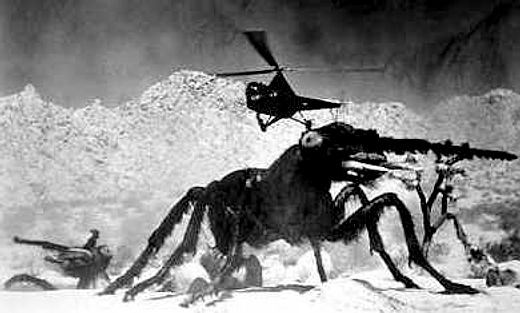
The Giant Children who shortly make their advent oddly resemble both the sentient octopi of “The Sea-Raiders” and the industrious formicidae of “The Empire of the Ants.” Evolutionary sports, the Giant Children portend ambiguously for Homo sapiens. They also represent Wells’ re-visitation of Nietzsche’s Superman, a theme that crops up many times in his oeuvre, in Kipps (1905), for example, and in Tono-Bungay (1909). The Giant Children, soon Giant Adolescents, are Supermen in modo grosso. Becoming a fact in the world, they begin by their mere presence to alter the world. Normal men fear them and seek to confine them but succeed in scotching neither their spontaneous recurrence – “Herakleophorbia” has infiltrated the environment – nor their intention to procreate their kind. Other things, insects and rats, have grown monstrous too. Men suspect that a changed environment holds them already at bay.
In The Food Book III, “The Harvest of the Food,” Wells arranges for a prisoner, pardoned after twenty years into his brother’s custody, to see inexplicable sights on a railway journey from Dover to London. “Lord sakes,” the man observes, “them’s mortal great thissels growing out there on the bank.” A bit farther on the custodian-sibling must explain that hypertrophied thistles signify beyond themselves a new desperate politics: “It’s this here Boomfood stuff… What all the election’s about.” An agenda has articulated itself that calls for the extermination of the Giants, and the Giants themselves, aware of the existential issue, reluctantly resolve to unleash aggressive enmity against their would-be slayers. The leader among them speaks to his fellows, saying: “Make no mistake, brothers; in some way or other they will fight. The war has begun and we must fight it to the end.” While there will be “no easy victory,” if nevertheless but a few should survive, “we will scatter the food; we will saturate the world with the food.” The present humanity will then vanish into the age of gigantism. The Food ends with one of the Titans “looking up fearlessly into the starry deeps”; he is “a great black outline against the starry sky.”
The End of the World recurs in Wells’ work throughout the 1920s and 30s, sometimes as a passing reference and sometimes as the salient event. In Men Like Gods (1923), a group of Twentieth Century Englishman blunders through a freak of time into the far future, where a scientific utopia has overtaken the world. The Utopians remember a Time of Troubles in a remote century respecting which almost no documents survive. In The Shape of Things to Come (1933) and its translation to the silver screen, Things to Come (1935), Wells only slightly varies the apocalyptic narrative of The War in the Air and The World Set Free. In The Shape (both the book and the film), Wells supplies the details of war and de-civilization abundantly. The rescuers of rational order, the organization calling itself Wings over the World, are black-uniformed dictators who, like the founders of the World Republic in The World Set Free, never worry themselves about consulting those over whom they forcibly assert their governance. Wells urged in 1939, in a tense news conference filmed by British Pathé, that America and Russia should not enter the war, but that they should await a debilitating impasse and then collaborate in imposing their own air dictatorship on the exhausted belligerents.
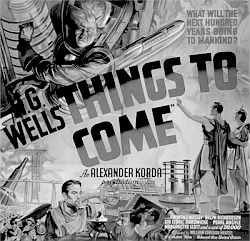
By the 1940s, Wells’ health had begun to fail. He had endorsed the war-enthusiasm of 1914, urging the defeat of German militarism. Disestablishing the Prussian monarchy, he believed, would open the way for world peace. The new conflict hit Wells hard, seeming at once to affirm his pessimism and to quash every last atom of his optimism. Wells had written in his Experiment in Autobiography (1934) apropos his scenarios of civilizational cataclysm and rebirth that, “Every man who has grown out of his infantile faith in the sanity of things about him and developed a social conscience, carries his whole world upon his shoulders.” He confides in the Experiment, “The Shape of Things to Come is the last important thing I have written.” The very last thing he wrote, however, was The Mind at the End of its Tether (1945), where he summons from his weariness his final invocation of human disaster.

The Mind, more a pamphlet than a book, proclaims, not so much that the human prospect has dimmed and diminished, as that it has vanished. “The writer finds,” Wells divulges, “very considerable reason for believing that, within a period to be estimated by weeks and months rather than by aeons, there has been a fundamental change in the conditions under which life, not simply human life but all self-conscious existence, has been going on since its beginning.” Admitting that, “this is a very startling persuasion to find establishing itself in one’s mind,” he fully expects that “his conclusions… will be entirely inacceptable [sic] to the ordinary rational man.” It is the flight of clarity and of the very possibility of clarity. Not only is “this world,” as Wells judges, “at the end of its tether,” but “the end of everything we call life is close at hand and cannot be evaded.” What does Wells mean by the phrase, “not simply human life but all self-conscious existence”? How might he have specified the “strange convincing realities,” looming fatally before the moment, to which he also gnomically alludes? His point, of course, is that “dismay” correlates necessarily and fatefully with “the ultimate disaster that confronts our species.” We will never grasp what kills us.
A college student once, having read The World Set Free, questioned the professor’s assertion that Wells had possessed the true gift of prophesy. Wells predicted that in the Twentieth Century civilization would be destroyed, the student objected, but here we are in the Twenty-First Century and civilization has not been destroyed. The professor responded with a question: How sure are you, lad, that civilization survived the Twentieth Century? Liberals believe that civilization survived the Twentieth Century because the Twentieth Century concluded in global liberal dominance, which liberals in a conflict of interest identify with civilization. One might ask, was Wells a liberal? Wells certainly did not subscribe to democracy, the bedrock of liberal ideology. He was by temperament closer to Plato and St. Augustine than he was to Herbert Spencer or to Beatrice and Sidney Webb. It might even be imprudent to characterize Wells solely as an ideologue of material and technical progress, as many skeptics on the right dismissively do. Wells’ work shows him to have been, right up to the end, a convicted believer much less in the inevitability of progress than in the inevitability of a crack-up. Wells will be a dose of sobriety for every besotted age.

Wow!
Submitted by antibureaucratic on Sat, 2011-10-15 10:21.
I love a lot of HG Wells' writing... The Time Machine is an all-time favorite, and the Sleeper Wakes I found very interesting, Thanks for posting this!
Wells across continents and generations
Submitted by Steve Kogan on Fri, 2011-09-23 18:20.
I wish I could locate my copy of Yevgeny Zamyatin's essay on Wells (1922), for which Tom Bertonneau's study offers a wonderfully analytical companion portrait and which demonstrates from yet another perspective how wide-ranging was the influence of Wells in his time. The closest I came to online was Patrick Parrinder's "Imagining the Future: Zamyatin and Wells" (Scence Fiction Studies, Spring 1973), in which I learned, among other things, that the writings of Wells prior to 1917 "had been abundantly available under the Tsar" and that they were among the first foreign works after Lenin seized power to be republished, thanks to Zamyatin, who "supervised a series of Wells translations between 1918 and 1926" (readers of Orwell remember Zamyatin, if only by name, as the author of We, about which Orwell wrote a review in 1946 and which he later incorporated in the world of 1984). The following from Parrinder's piece sums up what I remember most from Zamyatin's essay on Wells : "Two factors dominated Zamyatin's enthusiasm for the English writer. There was Wells' standing as a creator of modern myths: Zamyatin saw the scientific romances, which were his chief interest, as a species of fairy tale reflecting the endless prospect of technological change and the rigorously logical demands of scientific culture. They were the fairy tales of an asphalt, mechanized metropolis in which the only forests were made up of factory chimneys, and the only scents were those of test tubes and motor exhausts. Thus they expressed a specifically Western experience: for the reader in backward Russia, the urban landscapes which had produced Wells, and not only those he described, belonged to the future. Zamyatin was enough of a determinist to feel that Wells's expression of the twentieth-century environment alone constituted an essential modernity. He denotes this side of Wells by the symbol of the aeroplane soaring above the given world into a new and unexplored element. Just as the terrestrial landscape was transformed by the possibility of aerial photography, war and revolution are now transforming human prospects. Zamyatin calls Wells the most contemporary of writers because he has foreseen this, and taught men to see with 'airman's eyes.'"
I offer these notes in appreciation of "The End of the World, Part I: H. G. Wells" and look forward to Part II and whatever essays may later come "From the desk of Thomas F. Bertonneau."
@ Dr Bertonneau
Submitted by mpresley on Thu, 2011-09-22 22:26.
"...a handful of entrepreneur-geniuses are on the verge of perfecting manned space flight as a privately owned and operated business proposition."
There exists an unusual irony within goal oriented "for profit" scientific efforts (or any profit endeavor, for that matter). Although the tasks are undertaken for "selfish" reasons (that is, to make the entrepreneur money), if successful it always benefits the larger group. Demand is always logically prior to business success, even if it is a new product without a proven existing demand.
When government undertakes efforts such as space exploration, there are the so-called spin-offs, but it is more difficult to gauge the overall social benefit from a strictly economic calculation. Also, there are no "objective" measures of social intangibles such as national pride, etc., yet they nevertheless exist, and are nevertheless important. Whatever the calculation may be, most would likely agree that the space program created a benefit exceeding alternative tech spending, as witnessed by the the recent “green energy” debacle that is/was Solyndra.
We cannot forget, either, that the space program originated in the 1950s as a result of the existential threat of Soviet Communism. This is often overlooked in discussions about its worth. Now, with the demise of the USSR, and the questionable future of American economic well being, we watch the ISS slowly fall apart, and it appears that neither Russia nor the US are in the mood for further investments. Obama promised to send men to Mars by 2030, but no one takes his words seriously, least of all Obama himself.
Turning to Wells, the current essay encouraged me to read The Invisible Man last night, and the night before. Here, a theme may be the lack of any rational plan for the experiments that are described. It is a technology that is not wanted, and that has no practical usefulness (in spite of an at first seeming appeal). Also, we are reminded that we must always be wary of unintended consequences associated with new technology. The invisible man was savagely beaten to death by those he cheated.The good men associated with Solyndra will be luckier, I imagine.
@Capodistrias
Submitted by Thomas F. Bertonneau on Thu, 2011-09-22 16:04.
I heartily second Capodistrias’ comment. Most conservatives are phony conservatives – for example, the whole pack of GOP candidate-nominees for the 2012 presidential election. The actual conservatives to whom I was referring in the Wells essay are people like Capodistrias who read The Brussels Journal and who identify, more or less, with its range of positions.
In a related matter, I happened across the following passage while revisiting Wells’ Experiment in Autobiography (1934):
"If anyone wants a real measure of the unfruitfulness of the Socialist movement, if he wants to realize how like it was to the bag of a hopeful but easily diverted collector into which nothing worthwhile was ever put, let him turn his mind for a moment to the adventure of flying. Let him compare the amount of hard work and detailed invention, the patient gathering and development of knowledge and experience, the generous mutual help and mental exchange, that have brought flying in a third of a century, from a dream infinitely less hopeful than the original Socialist project, to the world-animating reality it is today. Side by side with that vigorous contemporary thrust of the human mind, the literature of Socialism is a pitiful repetition of passing remarks and ineffectual promises."
These words, it strikes me, are as applicable to Obama Socialism or to the EU bureaucracy as to the fumbling early-Twentieth Century socialist projects to which Wells applies them. It is useful to call to mind that, in the very moment when the American Nation has dramatically abandoned its vanguard role in manned space flight, a handful of entrepreneur-geniuses are on the verge of perfecting manned space flight as a privately owned and operated business proposition. Let us hope that this is the actual “Shape of Things to Come.”
Sad Truth About American Conservatism
Submitted by Capodistrias on Thu, 2011-09-22 14:27.
Prof B said:
"Conservatives do not recognize crony capitalism or “multi-national corporations” as embodiments of a sane market."
Yes, true. Also true is that they usually don't recognize crony capitalism at all, they're blinded by ideology and sometimes by their own financial self-interest.
Nuclear weapons and planning
Submitted by Thomas F. Bertonneau on Mon, 2011-09-19 06:39.
Wells was curiously right and wrong about nuclear weapons, but I judge him to have been more right than wrong. Historically, the first use of nuclear weapons created a psychological atmosphere in which they would not be used again – and have not to date. In The World Set Free, the same thing happens; but where historical reality differs from the fictional scenario is that in the latter the “World Republic” rounds up the arsenals and forbids the manufacture of the weapons, keep the ability to do so under a ban. They succeed because the use of the weapons has created abhorrence against them. In reality, the weapon “proliferated” while a ban on its use remained in effect. Nevertheless, it is easy to imagine that, in our world, the real world, nuclear weapons will be used – by Iran against Israel or Pakistan against India or North Korea against Japan or the United States, after which there will be retaliation.
In the novels that my article reviews the End of the World comes about because technical innovations – new elements of material culture, as the anthropologists would say – strain long-standing, gradually built-up social arrangements and the fabric of society gives way. Conservatives might correct Wells in this way: It is not only through the haphazard, unthought-out introduction of technical novelties that the social fabric comes under strain. Non-tangible innovations also “stick up the works.” The whole panoply of Left-Liberal, “Progressive” legislation of the post-WWII period is such a haphazard, unthought-out imposition on the fabric of society, whose effects alarmingly resemble the mayhem produced by atomic energy or aerial navigation in Wells’ novels.
Wells urged a need for “planning” and “foresight,” which he called “vision.” The goal of planning, as Wells saw it, could only be a global utopia. The conservative critique of the existing actual situation seems to me to be that it is the disastrous result of fake planning and a lack of foresight. Conservatives want to dissolve the supra-national bodies (the EU and the UN) and “devolve” the basis of world-politics back to the sovereign nation-state, but this will, of course, require actual planning and actual foresight. So conservatives may be said to agree with Wells that, let us say, a plan for society is not a bad thing. In the USA we call it the Constitution. Had Americans heeded their plan they would probably not be in such dire straits today. Where was Wells wrong? Wells never appreciated the market although he grew affluent by participating in it. (He was an enormously commercially successful author.) Conservatives differ from Wells in recognizing that no plan can account for everything and that the market is a kind of “plan-less but rational” institution whose benevolence the plan ought to encourage. Conservatives do not recognize crony capitalism or “multi-national corporations” as embodiments of a sane market.
The great value in Wells is his sense of the precariousness of any existing situation and of the complacency that prefers not to notice that precariousness.
I suspect that Wells would have appreciated Ishiro Hondo’s Godzilla, which is about the unforeseen consequences of nuclear testing in the Pacific, with the monster symbolizing the nuclear “genie” unleashed.
Looking forward to the next installment of the end...
Submitted by mpresley on Mon, 2011-09-19 00:13.
Thanks to Tom Bertonneau for bringing back many memories during my weekend. The essay evokes many different ways of thinking about a particular topic. Here are a few that came to mind for me:
These new-type soldiers must suppress their humanity...
I know what is meant. But sometimes I wonder about it. In this context “humanity” is the quality of being humane, or kind and benevolent; but another definition is that quality of being human. When one looks out over the history of humanity, one doesn't really observe much humanity at all. I remember Peter Ouspensky writing that history is the history of war and crime. Perhaps it is better to suppose that there is an equilibrium, and that for every act of kindness we must necessarily have its opposite.
The Martians dominate the battlefield. Occasionally, a crack British gun crew or an astute dreadnaught commander scores a tactical victory.
A vast superiority of technology would render any invading force victorious, but only if the invader has the will to use their technology. In 1861 one armored car with, say, one General Electric mini-gun (a Gatling-type 30 caliber heavy machine gun) could have allowed the possessor to defeat any army (assuming of course that they had the means to support it). Today, the same weapon would just cause a suitably advanced nation a minor inconvenience. It is a good thing microbes are on our side.
The continuation of that war twenty-five years later concluded with the actual use of atomic bombs.
Any major advance in weaponry is both destabilizing and problematic. As it proliferates, stability or equilibrium manifests once again. The A-Bomb is an interesting case. Today there is much hand-wringing about its use twice over. Back in the day, in 1945, no one understood anything about it, and because of that, views were different. Pop and crew were flying the Burma route inside the Indo-China theater when they heard about the surrender. At first everyone thought the radio announcer had misspoken. They were all familiar with bombs, but not a single bomb that could effectively destroy a city. Not even the horror of the Tokyo or Dresden runs had the same psychological impact. It was only later that these seasoned fighters understood that war had taken the next quantum leap, and that because of it war became ridiculous as a policy option—at least the kinds of all out wars most recently experienced. Due to the A (and later H) bomb's psychological impact, these weapons ceased to be instruments of war, but instead became objects of peace (the MAD policy attributed to Robert McNamara, and SALT). Henceforth, even small yield tactical bombs, rockets, and torpedoes were never used in any conflict, as far as we know.
Wells invokes “intelligences greater than man’s,” mentalities “vast, cool and unsympathetic,” by which men have been “scrutinized and studied...
These are the most frightening villains, because you can't reason with them. A modern-day example, and perhaps the most frightening, is “the Alien” from the first two eponymous movies. One of the humans (maybe it was the ship's android) describes its beauty: “You still don't understand what you're dealing with, do you? The perfect organism. Its structural perfection is matched only by its hostility. I admire its purity. A survivor … unclouded by conscience, remorse, or delusions of morality.” Like all real bogeys, the Aliens “mostly come out at night.” And because they are the perfect enemy, they must be confronted perfectly...once located you must “take off and nuke the site from orbit. It's the only way to be sure.” Here, the atomic bomb, the ultimate offensive force, and the most horrific, is used in self-defense against man's most horrific nightmare.
I also want to mention a film that might cause my estimation in the minds of some to go down another notch or two, but I'm nevertheless obligated to highlight it within Dr. Bertonneau's context. That is, the 1954 Japanese movie, Godzilla (Gojira). Even the addition of Raymond Burr to the American release does nothing to diminish the film, and may in fact increase its appeal for some.
At least it's not a YZ comment
Submitted by Capodistrias on Tue, 2011-09-13 19:41.
I love the title: The End of the World, Part I: H.G. Wells
Well, as another Bard said: All's Well That Ends Well